By DOUG LEIHBACHER
Fire investigation methodology is described in National Fire Protection Association (NFPA) 921, Guide for Fire and Explosion Investigations. It requires a systematic approach to determining fire origin and cause. The fire investigator must keep an open mind and follow the scientific method before drawing any conclusions about the fire cause. One of the primary tenets of this systematic method, not to mention common sense, states that, first, it is necessary to determine where the fire originated before it is possible to accurately determine what caused it. If the investigator is looking in the wrong area, he will make a faulty cause determination.
The various marks and patterns permanently imprinted on the structure and contents by the smoke, heat, and fire point the observant fire investigator in the direction of area of fire origin. When interpreted properly, these burn patterns allow the investigator to trace the path of fire spread in reverse; this will lead him back to the area where the fire originated to determine what caused the fire. When the area where the fire originated is found, it is secured and processed to determine the cause. Burn patterns are the geometry of fire investigation and, when understood properly, make the area of fire origin “pop out” at the investigator.
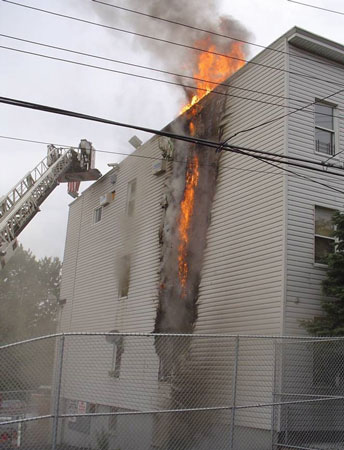 |
| (1) “V” pattern forming on the outside of a building. It produces an arrow that points to the room where the fire started. (Photos by author unless otherwise noted.) |
Although in some jurisdictions, fire investigation is done by the police, more commonly, fire investigators come from the ranks of the fire service. Still again, some communities form joint police/fire task forces that are charged with conducting fire investigations using a team approach. Regardless of their backgrounds, individuals making the career choice to become fire investigators must meet the performance requirements outlined in NFPA 1033, Standard for Professional Qualifications for Fire Investigator, and follow the methodology delineated in NFPA 921.
Some firefighters transition into fire investigation early, and some later in their careers. Changing one’s focus from fire suppression to fire investigation can be challenging. However, fireground experience can be invaluable in understanding how fire develops and moves through a structure. For example, observing flames propagate inside fire buildings during a search provides experience-based knowledge that can’t be learned in books. Experiencing how fires travel in buildings gives firefighters a unique understanding of the fire dynamics so important to correctly determine fire cause. However, even though they may have extensive fireground experience to call on, mentally reversing the fire development process, studying burn patterns, and determining the area of fire origin are new skills to learn and may take some time to develop. However, with repetition and supervision, the investigator’s fire pattern acuity will improve and it becomes simpler to correctly interpret fire/burn patterns. Then, confidence develops when one realizes that, in many cases, the burn patterns point to the area of fire origin like an arrow. The purpose of this article is to assist fire investigators in recognizing and correctly identifying common fire patterns they will encounter.
What Are Fire Patterns?
Fire patterns are formed when the products of combustion come into contact with a vertical or horizontal surface such as a wall, floor, ceiling, or home furnishing. Smoke patterns are deposits of carbon on walls and ceilings, carried there in the heat plume.
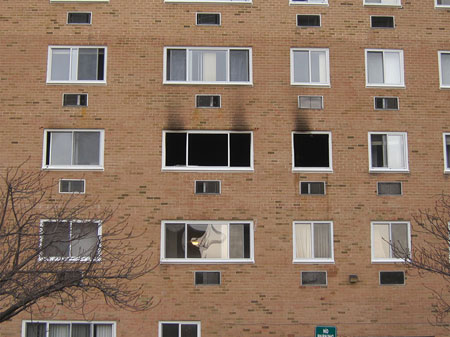 |
| (2) Exterior smoke patterns often point the investigator to where the fire originated. |
Flames are conical; therefore, a burn pattern made by a flame against a vertical plane (wall) will have a conical shape-think of it as the flame shape of a campfire. Conversely, the heat/smoke column forms an inverted cone that gets wider as it rises because of air entrainment. When this plume intersects a wall, it deposits carbon particles that leave an inverted cone pattern that resembles a “V” in two dimensions, hence the term “V pattern.” The farther away from the wall that the fire originates, the higher and rounder the bottom of the V will be on the wall. Like the top of a cone, when it reaches the ceiling (a horizontal plane), it leaves a circular pattern. However, this ceiling pattern is often obscured quickly as heat and flame roll across the ceiling toward a vertical channel or vent point. When a flame and a smoke column intersect a wall at the same time, an hourglass pattern may form. The width of the fire pattern often coincides with the width of the burning fuel package.
Systematic Observation
Observation of fire patterns begins on the outside of the building, where the investigator conducts a 360° survey of the building, taking note of areas where external fire and smoke patterns are observed. This will help the investigator determine where to look inside. The investigator continues his systematic examination as he enters the building, working from the area of least damage to the area of greatest damage as reflected by the fire patterns inside. The areas farthest away from the fire will be cleaner. As the investigator approaches the fire area, smoke stains will appear on the upper walls and get lower or descend as he gets closer to the room of fire origin. Flame patterns may appear on the ceiling outside of the door.
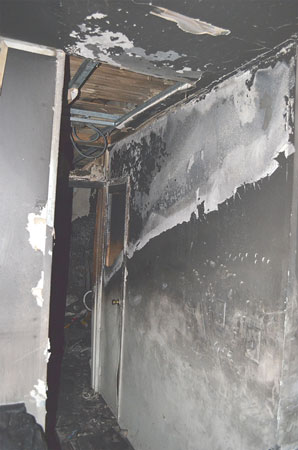 |
| (3) A descending heat pattern on a gypsum board wall leading to the room of fire origin. |
A look at the door jamb will indicate the direction of fire travel with the most intense and lowest charring on the fire side of the jamb. Patterns on door jambs are sometimes referred to as indicators because they indicate the direction of fire travel; they slant downward toward the side of the jamb where the fire occurred. When comparing both sides of the jamb, if the fire is lower on one side of the jamb than the other side, it indicates that the fire is coming from that side.
Inside the room of origin, take a look at the contents, walls, and ceiling to determine where the damage is the greatest. For example, sometimes fire enters the ceiling, and in one area, the joists are deeply charred, even burned away. The area of greatest destruction (greatest mass loss) may indicate the area of the fire’s origin. You can observe similar patterns with wall studs; the studs that are burned the most are closest to the area of fire origin. This is also referred to as “depth of char.”
High Fire
Fire investigators describe “high fire” as heat and fire patterns observed primarily in the upper regions of the room with limited heat damage at floor level. These burn patterns can result from fire that originates either close to ceiling level or in the ceiling itself, such as from a light ballast or a candle fire that originated on top of a mantle or tall dresser. More commonly, however, high fire patterns indicate a flame front migrating across the ceiling and upper wall areas from another room. Descending high fire or smoke patterns direct the fire investigator to continue moving in the direction of the greater, lower fire damage.
Fire Development and Burn Patterns
As mentioned above, burn patterns are the result of flame, smoke, or heat plumes intersecting a horizontal or vertical surface such as a wall, ceiling, or piece of furniture. Fire plumes are three-dimensional and conically shaped. Thus, they usually leave a two-dimensional V-shaped pattern when they intersect a wall and a circular pattern on a ceiling. For a given height, the closer the fuel package is to a wall, the lower on the wall the pattern will occur. If the fuel package is farther from the wall, it will intersect it at a higher level. A wider fuel package will leave a wider V pattern than a narrower fuel package.
When interpreting burn patterns, it is also important to consider the relative combustibility of the fuel package (e.g., was it a competent fuel source?), its heat of combustion, any ventilation or air currents (drafts) in the area, and the direction of the hose stream advance.
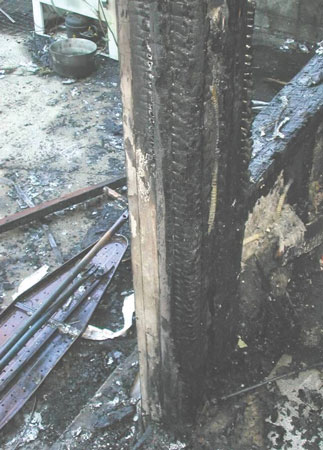 |
| (4) Charring on the right side of the door jamb framing indicates that the fire was to the right. |
The stage of fire development has a profound influence on the fire patterns imprinted within the building. The earlier the fire is extinguished, the clearer the fire patterns are. A fire that is extinguished in its incipient stage provides the most unambiguous patterns. As the fire develops, spreading from one combustible to another, each successive fuel package adds its own pattern and, often, they grow together, leaving the investigator to determine which pattern came first. In this case, the investigator must look to the area of greatest destruction, deepest charring, and greatest mass loss-i.e., the area that burned the longest. In all probability, the area that burned the longest and sustained the greatest destruction is the area where the fire originated.
Note that there are infrequent cases where this is the exception. For example, if there were victims trapped, resources may have been deployed to rescue operations, allowing areas to burn longer. This delayed extinguishment can result in greater damage and mislead the investigator unless he interviews the responding firefighters and learns about the fire attack scenario deployed. Similarly, areas in proximity to ventilation openings can exhibit greater charring or mass loss because of the increased supply of oxygen, allowing combustibles to burn more vigorously.
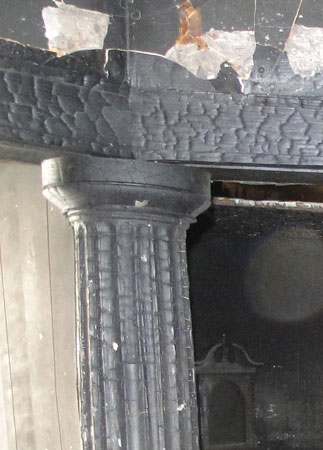 |
| (5) A high burn or smoke pattern commonly indicates that you are getting closer to, but not in, the area of origin. |
Eventually, if the fire reaches the flashover stage, all burn patterns can merge into one indistinct uniform burn. Post-flashover fires can create new patterns driven by ventilation and areas of air intrusion, not fuel packages. At this stage of fire development, fire patterns, the lowest burn, the deepest charring, and so on may only indicate areas of intense burning based on available oxygen and look very different than fires extinguished pre-flashover. Knowing if the fire flashed over is important information to have in your burn pattern analysis. Although flashover often creates a uniform burn, the area of origin still burned longer. Although more difficult, the area of origin can still be found after careful depth of char and mass-loss analysis.
Protected Areas and Scene Reconstruction
As mentioned above, fire burns in three dimensions. A flame has a height, width, and depth. Therefore, the burn pattern it leaves is also three-dimensional. When studying and documenting the area of fire origin, fire investigators often must reconstruct the area of origin by replacing burned pieces of furniture and other objects that were moved, toppled, or dislodged during fire suppression. Investigators replace these contents by observing protected areas on which these furnishings sat during the fire, similar to putting a puzzle together. When the items are back in place, a three-dimensional view of the fire becomes visible. Protected areas are often found on floors where objects sat during fire development.
![(6) A wide “V” pattern points to the area of fire origin. <i>[</i>Photo courtesy of Yonkers (NY) Fire Investigation Unit.]](https://emberly.fireengineering.com/wp-content/uploads/2016/01/1601FE_LeihbacherFeaturePic6.jpg) |
| (6) A wide “V” pattern points to the area of fire origin. [Photo courtesy of Yonkers (NY) Fire Investigation Unit.] |
Carefully evaluate patterns found on floors. An irregularly shaped pattern on a floor is not necessarily the result of an ignitable liquid pour. Commonly, irregular burn patterns on a floor are simply the result of drop-down, radiant heat, melting foam furnishings, or protected areas whereas irregularly shaped objects such as clothing were lying. If an ignitable liquid is suspected, take a sample of flooring to verify the hypothesis.
Multiple V Patterns
According to NFPA 921, two or more separate and distinct areas of fire with no connecting fire indicate an incendiary fire. If separate fires occur in two different rooms or in remote areas of the building with no means of fire communication (conduction, radiation, convection, and so on) between the two, it is a strong indicator of an intentionally set fire. However, when two separate areas are seen in the same room, the investigator must carefully consider drop-down and fire travel. When evaluating V patterns in large, open areas or fully developed commercial fires where numerous fuel packages are involved and combustible merchandise can fall from shelves, investigators must use caution when evaluating the fire patterns they observe. Lampshades ignite and drop, and pictures, curtains, paintings, and wall posters can burn and fall to the floor. Additionally, foam cushions melt and drip on the floor below. Combustible fuels and stock on store shelves or in upper areas close to the ceiling level ignite, melt, and can drop down, creating secondary V patterns.
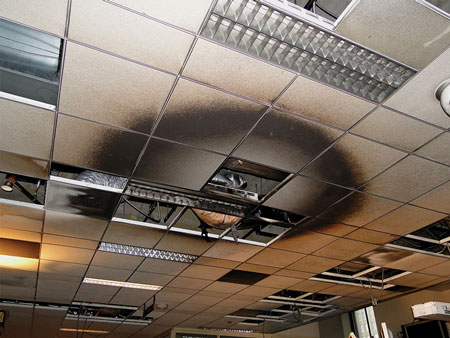 |
| (7) A circular pattern on ceiling tiles directly above where a fire originated. |
Depending on the fuels involved, these drop-down fires can create deep burns that may appear to be from a separate area of origin. When multiple areas of low burning are observed in the same room or within the same general heat plume, investigators must rule out drop-down before theorizing that there are multiple points of origin.
Atmospheric Effects
When interpreting them, investigators should be mindful that the fire patterns they see in the structure reflect not only the fire development but also the conditions present during the life cycle of the fire. Fire feeds on two things when it develops: fuel and oxygen. The fire investigator must consider the relative abundance of each at the time of the fire. A fire will leave thick smoke deposits and will travel great distances to find oxygen in a ventilation-controlled fire environment. At such fires, investigators can expect to see fire travel toward ventilation openings. However, you must also consider fire location, wind, and weather. A fire on the windward side of a building on a windy day can be driven away from a vent opening and lower to the floor. Conversely, in a fuel-controlled environment, where there is a light fuel load, flame spread will be primarily vertical from the fuel packages with limited horizontal travel unless it is influenced by air currents.
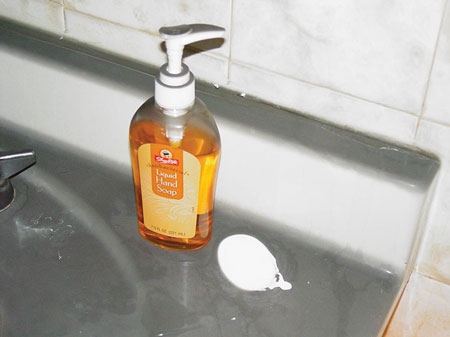 |
| (8) A protected area assists the investigator in placing an object back into its position at the time of the fire. |
Generally, fire spreads vertically from the area of origin until it meets a horizontal barrier, from where it travels horizontally in search of a vertical opening or ventilation point. If confined in a room with no place to go, the fire will bank down, lowering the hot gas level and increasing the pressure in the room. Knowing how the fire travels and develops is an important part of determining where the fire started.
The Influence of Firefighting Operations
Fire development and travel may also be influenced by firefighting tactics. Responding fire crews can provide valuable information to the fire investigator in describing the conditions they encountered while operating at the fire. The type of fire attack (offensive/defensive), the timing of suppression efforts, the direction of hose stream applications, wind strength/direction, and the position of ventilation openings will all influence burn patterns left on the structure.
For example, a given area may appear to have the deepest charring and lowest burning-a candidate for the area of origin. However, a conference with the operations chief may reveal that suppression in that area was delayed (allowed to burn longer) because of an extensive search and rescue operation and that fire was seen in a different area on arrival. For this reason, it is advantageous for the municipal fire investigator to respond on the initial confirmation of a structure fire to observe operations. When he is unable to do so, it becomes important for him to confer with responding firefighters.
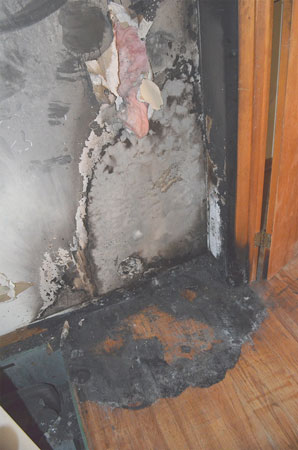 |
| (9) This pattern on the floor was the result of a pile of clothes that ignited accidentally while in contact with a floor-mounted heater, not an ignitable liquid pour. |
What makes the fire scene one of the most difficult of all crime scenes to investigate is the fact that both the fire and corresponding firefighting effort often destroy material evidence and alter the fire scene in significant ways. Searches result in realigned furniture and mattresses tossed about. Hose streams redistribute objects; dilute ignitable liquids; and push fire, moving it around the structure until a ventilation opening provides an outlet. Overhaul, out of necessity, pokes holes in walls and drops ceilings on top of potential evidence. Moreover, items subject to rekindle such as mattresses, chair cushions, foam pillows, and the like are removed to the outside of the structure where they can be saturated thoroughly. Veteran firefighters limit the amount of overhaul to what is necessary. Fully extinguishing pockets of fire in hidden and confined spaces certainly takes precedence but, when possible, coordinate overhauling procedures with fire investigation efforts to preclude unintentional destruction of crucial evidence.
Often, civilians say, “The firefighters do more damage than the fire!” These critics do not understand the necessity of finding and extinguishing hidden pockets of fire that could rekindle and cause greater damage than the first fire. Thorough overhaul is a cornerstone of fire suppression and a necessary part of the job. People intent on fire cause determination only can sometimes misunderstand overhaul. Those who have never fought a fast-moving fire racing through confined spaces do not understand the role overhaul plays in any aggressive attempt cut off fire spread, thereby saving a structure. That said, fire crews have to guard against “over-overhaul.” Often, with adrenaline running high, they pull entire ceilings when a simple inspection hole is all that is necessary. Similarly, furniture that is not subject to rekindle may be unnecessarily tossed out the window along with the fire patterns it contains.
 |
| (10) In this fire, each of the four walls and the ceiling were pulled entirely. Yet, as can be seen here, the wall furring strips are undamaged; hence, it was unnecessary to demolish the wall. If this were a case of arson, a key indicator of the fire’s location would be lost. |
Some officers think pulling down every inch of plaster and every stick of lath provides experience and training to rookie firefighters. This is antiquated thinking; the instruction should be in when it is and is not necessary to pull everything and how to protect evidence during overhaul. This is a time in the operation when fire officers directing overhaul operations have to supervise closely and coordinate overhaul activities with the on-scene fire investigators. The relative need for aggressive overhaul will vary from fire to fire and with the type of building construction. However, in many cases, when all visible fire has been knocked down, there is an opportunity to take a breather and let the investigator look at the scene before contents are tossed and walls are opened. The thermal imaging camera has shown to be a useful tool in limiting unnecessary overhaul.
Evaluating the Area of Fire Origin
The purpose of burn pattern analysis is to lead the fire investigator to the area of fire origin. When the investigator believes he has found the area of origin, the work of uncovering the cause begins. Three things must happen for a fire to occur: an ignitable fuel source, a competent ignition source, and an event to initiate the combustion process. If one of those is absent, a fire cannot occur. Any fire cause hypothesis must meet these criteria for there to be a clear determination.
 |
| (11) This fire occurred in a high school office. Burn pattern analysis placed the fire in the corner where a water cooler was located. It was eventually determined that a faulty relay on the hot water tank caused the unit to overheat and cause the fire. |
When the area of fire origin is found, it is photographed and carefully excavated to uncover the source of ignition. The ignition source might have been a candle, an electrical spark, a chemical reaction, resistance heating, or an incendiary device. As the area of origin is uncovered layer by layer, it is photographed each step of the way. In many cases, the ignition source is partially or completely destroyed by the fire. Whatever evidence is found must be documented and protected. If the evidence indicated a criminal act, it must be collected following evidence collection protocols with a documented chain of custody. If the evidence is of an accidental nature, preserve it in place for insurance purposes.
Careful fire pattern observation in the context of the fire development scenario helps determine the area of fire origin. This, along with accurate data from witness interviews, is the basis of sound fire cause determination and the stock-and-trade of every fire investigator.
DOUG LEIHBACHER is a 28-year fire service veteran and a battalion chief (ret.) with the Yonkers (NY) Fire Department. Leihbacher has written numerous articles on firefighting tactics for Fire Engineering, authored the vehicle fires chapter for Fire Engineering’s Handbook for Firefighter I and II, and has been an instructor at FDIC. He has a bachelor’s degree in education and an associate degree in fire protection technology. A certified fire investigator since 2000, Leihbacher conducts investigations of fires in the New York metropolitan area as a senior fire investigator with Russo Consultants.
Training Minutes: Arson and Fire Investigation
OVERHAULING FOR SUCCESSFUL FIRE INVESTIGATION
INTEGRATING ARCHAEOLOGY AND PHOTOGRAMMETRY WITH FIRE INVESTIGATION
Fire Engineering Archives

